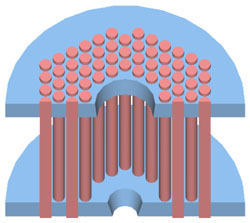Lattice Sends a Crystal Clear Signal

Listen to your radio on a long car trip, and you’ll hear the signal become garbled by noise on competing frequencies. Frequency competition is not just a problem for receiving signals: Microwave sources used in telecommunications produce extra frequencies that compete with the broadcast frequency. A paper in the 11 June PRL details a new way to squash the competition using a so-called photonic band gap structure. The periodic array of rods may be the best way to create narrow, high-frequency microwave signals for everything from satellites to cell phones.
Traditional microwave sources remove the competition by using a resonator, which amplifies only the desired frequency. The size of the resonator determines the signal frequency: The smaller it is, the higher the frequency it selects. But resonators cannot be shrunk without limit, so there’s an upper limit on the frequencies they can produce. Their size also limits signal power because millimeter-scale resonators are unable to dissipate the heat from high-power sources.
Now a group of researchers from the Massachusetts Institute of Technology has built a microwave source whose resonator is not size-dependent. The source is a gyrotron, a device that accelerates electrons through a strong magnetic field to produce microwaves. The microwaves pass through a lattice of 102 metal rods, called a photonic band gap (PBG) structure. Like the photonic crystals under development for visible light applications, the PBG structure appears translucent to some frequencies and reflective to others. In the MIT experiment, it reflects a specific microwave frequency back into the gyrotron, creating resonance. The result is a lot like a laser, explains Jagadishwar Sirigiri, a member of the MIT group: The resonance causes the selected frequency to grow into a powerful signal.
The team tested the PBG structure over a wide range and found that it resonated at only the specified frequency. The 23-mm-diameter lattice performed as well as a traditional 9 mm resonator, according to the team, so PBG structures could soon be used in radars, telecommunications satellites, and cell phones, to reach higher microwave powers and frequencies than ever before. “We think the PBG structure is a method for a breakthrough,” says Richard Temkin, the team leader.
“It’s quite a novel idea,” says Kevin Felch of Communication and Power Industries in Palo Alto, California. Felch believes PGB structures show “good promise” for use in radar and satellites. Temkin can imagine still another function for the new devices. “I know that at least one airline has been looking for a high frequency microwave source to cook their meals more effectively,” he says. “Maybe that will be our legacy.”
–Geoff Brumfiel


